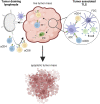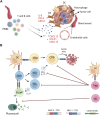Stromal and Immune Cell Dynamics in Tumor Associated Tertiary Lymphoid Structures and Anti-Tumor Immune Responses
- PMID: 35874810
- PMCID: PMC9304551
- DOI: 10.3389/fcell.2022.933113
Stromal and Immune Cell Dynamics in Tumor Associated Tertiary Lymphoid Structures and Anti-Tumor Immune Responses
Abstract
Tertiary lymphoid structures (TLS) are ectopic lymphoid organs that have been observed in chronic inflammatory conditions including cancer, where they are thought to exert a positive effect on prognosis. Both immune and non-immune cells participate in the genesis of TLS by establishing complex cross-talks requiring both soluble factors and cell-to-cell contact. Several immune cell types, including T follicular helper cells (Tfh), regulatory T cells (Tregs), and myeloid cells, may accumulate in TLS, possibly promoting or inhibiting their development. In this manuscript, we propose to review the available evidence regarding specific aspects of the TLS formation in solid cancers, including 1) the role of stromal cell composition and architecture in the recruitment of specific immune subpopulations and the formation of immune cell aggregates; 2) the contribution of the myeloid compartment (macrophages and neutrophils) to the development of antibody responses and the TLS formation; 3) the immunological and metabolic mechanisms dictating recruitment, expansion and plasticity of Tregs into T follicular regulatory cells, which are potentially sensitive to immunotherapeutic strategies directed to costimulatory receptors or checkpoint molecules.
Keywords: TLS; Tfh; Treg; neutrophils; tumor stroma.
Copyright © 2022 Rossi, Belmonte, Carnevale, Liotti, De Rosa, Jaillon, Piconese and Tripodo.
Conflict of interest statement
The authors declare that the research was conducted in the absence of any commercial or financial relationships that could be construed as a potential conflict of interest.
Figures


Similar articles
-
Dendritic cells type 1 control the formation, maintenance, and function of tertiary lymphoid structures in cancer.bioRxiv [Preprint]. 2024 Dec 27:2024.12.27.628014. doi: 10.1101/2024.12.27.628014. bioRxiv. 2024. PMID: 39763802 Free PMC article. Preprint.
-
Tertiary lymphoid structures in colorectal cancer - organization and immune cell interactions.Am J Clin Exp Immunol. 2024 Dec 25;13(6):236-245. doi: 10.62347/GRYY2849. eCollection 2024. Am J Clin Exp Immunol. 2024. PMID: 39839346 Free PMC article. Review.
-
An immune cell map of human lung adenocarcinoma development reveals an anti-tumoral role of the Tfh-dependent tertiary lymphoid structure.Cell Rep Med. 2024 Mar 19;5(3):101448. doi: 10.1016/j.xcrm.2024.101448. Epub 2024 Mar 8. Cell Rep Med. 2024. PMID: 38458196 Free PMC article.
-
Regulatory T cells infiltrate the tumor-induced tertiary lymphoïd structures and are associated with poor clinical outcome in NSCLC.Commun Biol. 2022 Dec 24;5(1):1416. doi: 10.1038/s42003-022-04356-y. Commun Biol. 2022. PMID: 36566320 Free PMC article.
-
Tertiary lymphoid structures and B lymphocytes in cancer prognosis and response to immunotherapies.Oncoimmunology. 2021 Mar 29;10(1):1900508. doi: 10.1080/2162402X.2021.1900508. Oncoimmunology. 2021. PMID: 33854820 Free PMC article. Review.
Cited by
-
Epigenetic targets to enhance antitumor immune response through the induction of tertiary lymphoid structures.Front Immunol. 2024 Jan 25;15:1348156. doi: 10.3389/fimmu.2024.1348156. eCollection 2024. Front Immunol. 2024. PMID: 38333212 Free PMC article. Review.
-
Tertiary lymphoid structures in diseases: immune mechanisms and therapeutic advances.Signal Transduct Target Ther. 2024 Aug 28;9(1):225. doi: 10.1038/s41392-024-01947-5. Signal Transduct Target Ther. 2024. PMID: 39198425 Free PMC article. Review.
-
Systems immunology spanning tumors, lymph nodes, and periphery.Cell Rep Methods. 2023 Dec 18;3(12):100670. doi: 10.1016/j.crmeth.2023.100670. Epub 2023 Dec 11. Cell Rep Methods. 2023. PMID: 38086385 Free PMC article. Review.
-
Identifying specific TLS-associated genes as potential biomarkers for predicting prognosis and evaluating the efficacy of immunotherapy in soft tissue sarcoma.Front Immunol. 2024 Apr 24;15:1372692. doi: 10.3389/fimmu.2024.1372692. eCollection 2024. Front Immunol. 2024. PMID: 38720884 Free PMC article.
-
In-depth insight into tumor-infiltrating stromal cells linked to tertiary lymphoid structures and their prospective function in cancer immunotherapy.Exp Hematol Oncol. 2025 Aug 10;14(1):105. doi: 10.1186/s40164-025-00695-8. Exp Hematol Oncol. 2025. PMID: 40784879 Free PMC article. Review.

